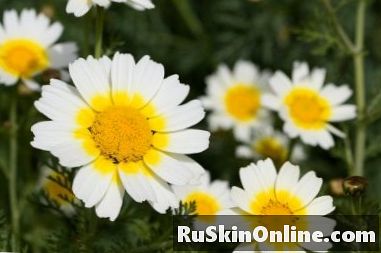
Content
- Chrysanthemums: Edible varieties for teas and salads
- Chrysanthemum coronarium: leaves and flowers are edible
- Cultivation of the Salachrysantheme
- Harvest chrysanthemums
- Tips

The Chrysanthemum coronarium is edible
Chrysanthemums: Edible varieties for teas and salads
That the flowers of many herbs and vegetables, but also of wild plants such as dandelions and daisies are edible, is already known to many people. But did you know that there are also edible chrysanthemums?
Chrysanthemum coronarium: leaves and flowers are edible
The edible Chrysanthemum is also known under the trivial names Speisechrysantheme, Salachrysantheme and gold flower or wildflower, botanists, however, as Chrysanthemum coronarium. It is a fast-growing, annual ornamental and spice plant that can grow up to 90 centimeters high. The Salachrysantheme belongs to the daisy family and is originally from southern China.
Cultivation of the Salachrysantheme
The edible Chrysanthemum prefers humus, loose soil and a partially shaded to sunny spot. The seeds germinate best at 15 ° C and should be brought forward in March. Alternatively, the sowing takes place directly in the field in the months of August to September, whereby the seeds should be covered with soil about one centimeter thick. The plant can also be cultivated in pots.
The chrysanthemum tastes intense bitter to bitter and is ideal as a spice for the Asian cuisine. If you do not like it so bitterly, cut off the white buds on the flowers - these contain the most bitter substances. The young shoots and leaves can be processed raw in salads and soups or steamed as vegetables. The blooming from July to September, white-yellow flowers are also edible, but only the petals. Once the plant flowers, leaves and shoots should no longer be used.
Harvest chrysanthemums
Use the plant parts as fresh as possible, but if this is not possible, leave leaves and flowers for several hours (the latter also days) in a bowl of water. Be sure to harvest only specimens that are self-produced or sold explicitly as edible plants - straight chrysanthemums are often brought up with pesticides and plenty of fertilizers. You can harvest as soon as the plant has reached a height between 10 to 25 centimeters. As new leaves and flowers keep coming up, you do not have to be afraid of a strong pruning.
Tips
The finely chopped, young leaves can be used as a spicy substitute for parsley. The flowers, however, taste good not only in salads or as a decoration of sweet and savory dishes, but also baked in pancake batter.